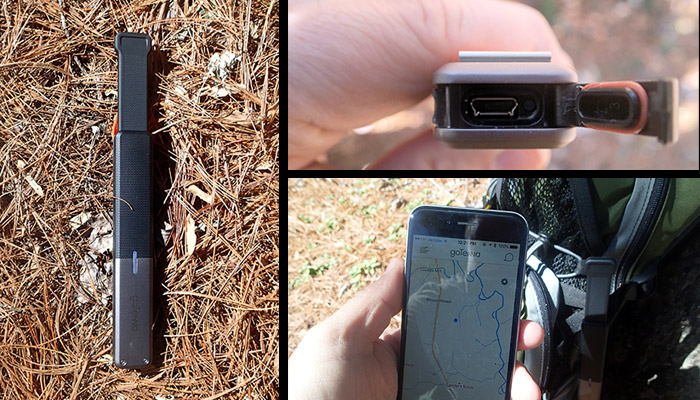
The goTenna works with iOS or Android devices.
Pair goTenna to your Smartphone via Bluetooth, and use the app to connect with other goTenna users, which can be up to several miles away. This system essentially turns your Smartphone into a walkie-talkie.
It takes less than a minute to create your own people-powered network, anywhere. This system does not require towers, routers, or satellites.
The manufacturer recommends that you attach your goTenna externally and as high off the ground as is practical for best results. Attach to the outside of your pack, or attach to your person in some manner, such as a belt loop or shoulder straps. When not moving about put the antenna where the signal is less likely to be obstructed by heavy foliage, hills and so on.
GoTenna is a cognitive digital radio that when combined with the app generates its own signal and then automatically coordinates with other units within range.
The key here is “radio”, which means a radio signal, so you have to be mindful of terrain and other factors that may interfere with the signal. The signal goes from one goTenna to another, so it can be considered a Line-Of-Site (LOS) communication device.
The system gives you the ability to text as a group using the device or you can text other users. For example, with this device, you can text your GPS coordinates to someone if you have GPS activated on your phone. The system also allows you to broadcast openly to anyone nearby that has the goTenna and corresponding app installed.
You may not know the person who hears your broadcast, but this can be important in an emergency. You can put out an emergency call in hopes someone can receive and respond, just as you would with any walkie-talkie/two-way radio. Again, only those with the goTenna installed can hear your call.
The goTenna is sold in pairs so you can give one to a friend. There is no point in you having the only one, so they are sold in pairs for this reason.
The goTenna is ideal for families and Prepper groups that want and need to stay in contact during a crisis, particularly in a grid down situation, and of course, every member of the family or group will need the goTenna device and app installed on their Smartphone. Once this is completed, you can communicate by text with anyone that has the goTenna.
The device needs to be charged as well as your phones, so a power source is important. Consider a small solar panel, for example, that can be attached to your pack so you can charge your phones and goTenna if the grid is down.

Remember this device is primarily designed for off-grid use, but it would be invaluable when the grid is actually down, but only if you have a way of charging the device and your phones. You need the means to charge devices when out in the backcountry, or at home on the back deck, as well, if the power grid fails.
The goTenna has a strap and snap so you can attach it to your belt or backpack, and the antenna can be extended a few inches as needed for reception.
Having a communication plan is an essential part of Prepping, and the goTenna is an ideal solution for any emergency where cell phone reception is a problem or can become a problem. If the towers are destroyed or you are not near one, for instance, your cell phone is useless until reception is restored.
Considerations
It is a 2W VHF radio, and so, the signal can be jammed or intercepted. The goTenna does work, and frankly, it works rather well, but an interception of sensitive information is possible and in some SHTF situations it should be expected. Do not reveal personal information, or information that would cause harm to you, your family or to your group.
It has a micro-USB for charging, built-in flash memory for storage of hundreds of text messages and, of course, it has Bluetooth capability. The battery is good for approximately 20 hours on standby. How long the battery actually lasts, of course, depends on usage, but if not used expect it to stay charged for 20 hours. Keep track of the charge (there is a battery charge indicator built in) so you are not caught without the means to communicate in a crisis.